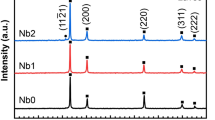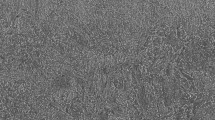Abstract
Corrosion-resistant Ni3(Si,Nb) alloys are promising materials of construction for hydrogen-production systems based on the sulfur-iodine thermochemical cycle. In this work, the corrosion rates of three different Ni3(Si,Nb) alloys were measured in boiling 70 wt.% sulfuric acid and a three-stage corrosion mechanism was identified, based on the composition and morphology of surface scale that developed. The α(Ni) + β(Ni3Si) eutectic constituent of the alloy microstructure was selectively attacked by acid and, when present, is detrimental to corrosion resistance. The G-phase (Ni16Si17Nb6) is more passive than the β-matrix and seems to contribute to a lower steady-state corrosion rate.









Similar content being viewed by others
References
S. Kubo, H. Nakajima, S. Kasahara, S. Higashi, T. Masaki, H. Abe, and K. Onuki, A Demonstration Study on a Closed-Cycle Hydrogen Production by the Thermochemical Water-Splitting Iodine-Sulfur Process, Nucl. Eng. Des., 2004, 233, p 347–354
L.C. Brown, G.E. Besenbruch, R.D. Lentsch, K.R. Schultz, J.F. Funk, and P.S. Pickard, High Efficiency Generation of Hydrogen Fuels Using Nuclear Power, General Atomics Report GA-A24285 Rev 1, 2003.
A.M. Russell, Ductility in Intermetallic Compounds, Adv. Eng. Mater., 2003, 5, p 629–639
D.W. Wakeman, F.G. Haines, K.J. Williams, T.J. Evans, and W. Barker, Nickel-Silicon Alloys, U.K. Patent 1041484-A, 1966
J.W. Newkirk, J.-H. Hsu, R.K. Brow, and T. Lillo, Chromium-Free Nickel Alloys for Hot Sulfuric and Sulfur Environments, Int. J. Hydrogen Energy, 2011, 36, p 4588–4594
S.-H. Zhang, The Development of Nickel Silicide Based Alloy for Sulfuric Acid Application, A Dissertation in Metallurgical Engineering of University of Missouri Rolla, 2000.
W. Barker, T.E. Evans, and K.J. Williams, Effects of Alloying Additions on the Microstructure, Corrosion Resistance and Mechanical Properties of Nickel-Silicon Alloys, Br. Corros. J., 1970, 5, p 76–86
P. Kumar, High-Temperature Ordered Intermetallic Alloys, Mat. Res. Soc. Symp. Proc., 1980, 39, p 537–554
T. Takasugi and M. Yoshida, Mechanical Properties of the Ni3(Si, Ti) Alloys Doped with Carbon and Beryllium, J. Mater. Sci., 1991, 26, p 3032–3040
C.M. Larson, The Corrosion of Nickel-Silicon Based Alloys in Sulfuric Acid, a Thesis in Material Science and Engineering of Missouri S&T, 2008.
F.X. Spiegel, D. Bardos, and P.A. Beck, Ternary G and E Silicides and Germanides of Transition Elements, Trans. Metall. Soc. AIME, 1963, 227, p 575–579
J.W. Newkirk and S.-H. Zhang, Corrosion Resistant Nickel-Based Alloy, U.S. Patent 6342181, 2002.
M. Davies, Materials Selection for Sulfuric Acid, 2nd ed., Materials Technology Institute, St. Louis, 2005
G. Kreysa and M. Schitze, Corrosion Handbook: Corrosive Agents and Their Interaction with Materials. Volume 11: Sulfuric Acid, 2nd ed., Wiley, New York, 2008
T.E. Evans and A.C. Hart, Corrosion and Passivation of a Nickel-Silicon Base Alloy in Sulfuric Acid Solutions, Electrochim. Acta, 1970, 16, p 1955–1970
C.T. Liu, E.P. George, and W.C. Oliver, Grain-Boundary Fracture and Boron Effect in Ni3Si Alloys, Intermetallics, 1996, 4, p 77–83
Standard Practice for Laboratory Immersion Corrosion Testing of Metals, G31–72, American Society for Testing and Materials, 2004.
W.W. Duecher and J.R. West, The Manufacture of Sulfuric Acid, Reinhold, New York, 1959
G. Priyotomo, S. Wagle, K. Okitsu, A. Iwase, Y. Kaneno, R. Nishimura, and T. Takasugi, The Corrosion Behavior of Ni3(Si, Ti) Intermetallic Compounds with Al, Cr, and Mo in Various Acidic Solutions, Corros. Sci., 2012, 60, p 10–17
R. Matsuhashi, H. Abo, S. Abe, and Hiroshi Kihira, Corrosion Mechanism of Stainless Steels in Highly Concentrated Sulfuric Acid, Corros. Eng., 1987, 36, p 578–585
G. Bohm and M. Kahlweit, On Internal Oxidation of Metallic Alloys, Acta Met., 1964, 12, p 641–648
E.A. Brandes, Smithells Metals Reference Book, 6th ed., Butterworths, Boston, 1983
R. Barlow and P.J. Grundy, The Determination of the Diffusion Constants of Oxygen in Nickel and α-Iron by an Internal Oxidation Method, J. Mater. Sci., 1969, 4, p 797–801
D.A. Jones, Principles and Prevention of Corrosion, 2nd ed., Prentice-Hall, New Jersey, 1996
U.R. Evans, Metallic Corrosion Passivity and Protection, Edward Arnold & Co., London, 1937
J.H. Chang, J.M. Chou, R.I. Hsieh, and J.L. Lee, Corrosion Behaviour of Vacuum Induction-Melted Ni-Based Alloy in Sulphuric Acid, Corros. Sci., 2010, 52, p 2323–2330
J.-H. Hsu, Understanding Corrosion of Ni3(Si,Nb) Alloys in Hot Sulfuric Acid, a Dissertation in Metallurgical Engineering of Missouri S&T, 2010.
Acknowledgements
The authors would like to thank Harry Meyer at Oak Ridge National Lab for his assistance with the Auger electron spectroscopy experiments, and Eric Bohannan at Missouri S&T for the XRD analyses. This work was supported by a NERI (National Energy Research Institute)-DOE (US Department of Energy) Project (DE-FC07-06ID14753).
Author information
Authors and Affiliations
Corresponding author
Appendix
Appendix
If one considers a typical thickness for the silica scale to be 30 microns (Fig. 6a), then using the density of amorphous silica (2.2 g cm−3) and the relative weight fraction of oxygen atoms in silica, one calculates an increase in mass of approximately 0.004 g cm−2 to create the scale. The typical coupon weight loss over the same corrosion time is about five times as great, indicating that coupon dissolution has the greatest effect on the overall change in coupon mass. It is difficult to accurately measure the amount of nickel sulfates in surface scale. But, based on the similar estimation, the weight change caused by the small amount of nickel sulfates (Table 2) is not critical.
Rights and permissions
About this article
Cite this article
Hsu, JH., Larson, C.M., Newkirk, J.W. et al. The Corrosion Behavior of Ni3(Si,Nb) Alloys in Boiling 70 wt.% Sulfuric Acid. J. of Materi Eng and Perform 25, 510–517 (2016). https://doi.org/10.1007/s11665-016-1883-0
Received:
Revised:
Published:
Issue Date:
DOI: https://doi.org/10.1007/s11665-016-1883-0




